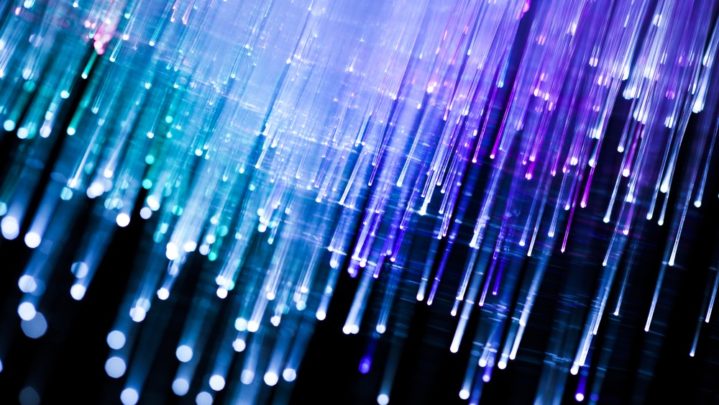
Presented by The Globe Building for
5 Things Every Business Owner Should Know About Data Speed
It’s no surprise that the type of business internet connection you invest in is critical. Connectivity through phone lines–although it is the most widely available option–is by far the slowest type. Cable internet is faster and available most places, but isn’t the speediest of them all. The fastest type of internet connection is fiber-optic cable.

Internet speed is measured in Mbps or “megabits per second.” Additional factors that can affect your satisfaction with your internet connection are download versus upload speeds (upload is more expensive and harder to come by with cable) and the number of users using your connection (including humans as well as devices).
According to Jeremy Salvatori, Property Manager of the fiber-equipped Globe Building in downtown St. Louis, “If you manipulate large amounts of data, you can’t move it to the cloud or to a data center on a typical home cable or standard business cable internet connection. At home, you can get up to 100 Mbps, but never consistently. For comparison, 10 or 20 Mbps is enough to watch Netflix. With your typical business connection, you can have 100 Mbps most of the time, maxing out at 500 Mbps. With fiber, you have 10,000 Mbps guaranteed to be always up, but it can cost tens of thousands of dollars to get it in place. For companies that need high upload speeds, having the existing fiber providers right on site is a big advantage.”
Lighting-fast data speed launches high productivity.
It’s not difficult to find reasons to maximize data speed in the interests of productivity. If e-commerce transactions take less time, there is time for more transactions and more revenue in a shorter amount of time. Similarly, if a worker is not idle waiting for a file to download or upload, but can instead proceed with the task at hand, the worker can complete more tasks in a given hour or day. In addition, a worker who isn’t anxious about completing an internet-dependent task due to slow data speed is a happier, less stressed-out worker. Virtual collaboration via the web, a money-saver in its own right, is more efficient, effective and user-friendly on a network with more bandwidth.
Imagine that your network is infinitely reliable.
Unlike phone lines or cable, fiber networks typically don’t go down unless the fiber is deliberately cut. Phone and cable internet depend on existing networks of wires–copper phone lines and coaxial cable–to send electronic signals. They are vulnerable to electromagnetic interference that is sometimes caused by proximity to heavy machinery and to interference from weather. Fiber, alternatively, works by sending signals with light rather than electricity and is not susceptible to these conditions. A more reliable network results in a reputation of reliability for your company, and eliminates unintentional interruptions to service and productivity.
For the Globe Building, it’s the fiber optics available, combined with the presence of the data centers in the building, that make this type of data movement easy and fast. And for less technical companies, simpler things are also more reliable at the Globe, which means Skype doesn’t freeze, phone calls sound clear, and the internet is always working.

Fiber scales like nobody’s business.
Due to its use of light instead of electricity, signal strength for fiber networks is more robust than for phone and cable networks. Fewer switches along the wire are needed for fiber, reducing maintenance costs. Also, the signal for an entire building is consistently stronger throughout when using fiber compared to cable. In addition, a fiber optic network backbone supports a higher number of users, and more efficient uploading of large files, such as video and large images.
Hacked? Not your network.
Just like its vulnerability to the elements and to electromagnetic interference, cable is significantly more vulnerable to cyber crime than fiber. Due to the nature of fiber, a hacker would have to physically cut the fiber in order to hack the signal. Although not impossible, this is much harder to do than to hack into cable. For the fiber customer, this translates to less investment in back-up security systems for the network and more confidence in the security of the data. “The building understands the needs of a data-center provider,” says Datotel president David Brown, tenant of the Globe Building.
Location cubed.
How do you get access to fiber, then, if you don’t want to spend thousands of dollars to make it available for your business? When looking for a space, make sure you find out what type of line runs all the way into your work space. Downtown St. Louis has a significant amount of available fiber, but practical access is complicated. For example, if fiber is available in the area, but your office will be on an upper floor of a building that does not have the fiber vertical run, you won’t benefit from the fiber unless you make a significant investment. The Globe Building is in an ideal location to access fiber, making fiber easily accessible throughout all the floors of the building.
Based on this information, why doesn’t everyone just use fiber? The biggest obstacle, of course, is availability. Fiber isn’t available everywhere, but if you find yourself near it, there are numerous reasons to take advantage of it.
Read more about how The Globe building helps business owners manage their infrastructure needs. To schedule a time for a tour or to speak to someone today, go to globebuilding.com.